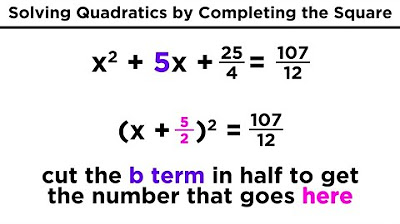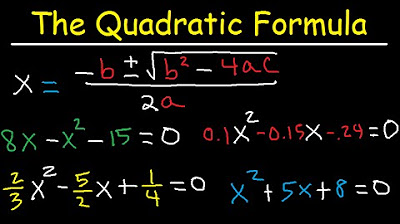Completing The Square Method and Solving Quadratic Equations - Algebra 2
TLDRThis educational video script offers a comprehensive guide on solving quadratic equations through the method of completing the square. It walks viewers through various examples, demonstrating how to transform equations into perfect square trinomials, factor them, and find solutions, including real and imaginary numbers. The script simplifies complex expressions and encourages practice with additional problems, ensuring a clear understanding of the technique.
Takeaways
- 📚 The video focuses on solving quadratic equations by completing the square, a method that involves manipulating the equation to form a perfect square trinomial.
- 🔢 The first step in the process is often to isolate the quadratic and linear terms by moving the constant term to the other side of the equation.
- 🎯 To complete the square, find half of the coefficient of the linear term, square it, and add this value to both sides of the equation.
- 📐 After completing the square, the left side of the equation can be factored into a binomial squared, simplifying the process of finding the solution.
- 🤔 The technique is particularly useful for equations that are difficult to factor, including those with fractions or complex expressions.
- 📉 When the equation is not easily factorable, completing the square is a reliable alternative method to find the roots of the quadratic equation.
- 🤓 The video provides multiple examples to illustrate the process, including handling different scenarios such as when the equation cannot be factored.
- 🛑 If the completed square results in a negative number under a square root, the solutions involve imaginary numbers, indicated by 'i'.
- 📌 The script emphasizes the importance of simplifying expressions and working with common denominators when necessary.
- 📝 The process involves algebraic manipulation, including factoring, adding, and taking the square root of both sides of the equation.
- 📉 The video concludes with a summary that completing the square is a versatile method for solving quadratic equations, especially when factoring is not feasible.
Q & A
What is the first step to solve the equation x^2 + 4x + 3 = z by completing the square?
-The first step is to subtract 3 from both sides of the equation, resulting in x^2 + 4x = z - 3.
How do you find the number to add to both sides to complete the square for the equation x^2 + 4x?
-Take half of the coefficient of x, which is 4, and square it. Half of 4 is 2, and 2 squared is 4.
After adding the squared number to both sides, how can you factor the left side of the equation x^2 + 4x + 4?
-The left side factors into (x + 2)^2.
What is the next step after factoring the equation (x + 2)^2 = 1?
-Take the square root of both sides, resulting in x + 2 = ±1.
What are the solutions to the equation x + 2 = ±1?
-The solutions are x = -1 and x = -3.
How do you complete the square for the expression x^2 + 6x?
-Take half of 6, which is 3, and square it to get 9. Add 9 to both sides of the equation.
What is the factored form of the trinomial x^2 + 6x + 9?
-The factored form is (x + 3)^2.
What is the process to solve the equation x^2 - 6x - 9 by completing the square?
-Add 9 to both sides to get x^2 - 6x = 9, then add 9 to both sides again to complete the square, resulting in (x - 3)^2 = 18.
How can you simplify the square root of 18?
-The square root of 18 can be simplified to 3√2.
What are the steps to solve the equation 2x^2 - 8x + 9 = 0 by completing the square?
-Subtract 9 from both sides to get 2x^2 - 8x = -9, factor out the 2 to get 2(x^2 - 4x) = -9, complete the square inside the parentheses to get 2(x - 2)^2 = -1, divide by 2, and take the square root of both sides.
Outlines
📚 Introduction to Solving Quadratics by Completing the Square
This paragraph introduces the method of solving quadratic equations by completing the square. The first example given is X^2 + 4x + 3 = Z, where the equation is simplified by subtracting 3 from both sides. The process involves adding a specific number to both sides to form a perfect square trinomial, which is then factored into (x + 2)^2. The right side of the equation is adjusted accordingly, leading to the solution x = 1 or x = -3. The paragraph also mentions a technique for factoring expressions with fractions and provides additional examples.
🔍 Factoring and Completing the Square for Quadratic Equations
This paragraph discusses the process of factoring trinomials and when it is not possible, how to solve them by completing the square. An example of factoring is presented with the equation x^2 - 6x - 9, which factors into (x - 3)(x - 3). The paragraph then moves to an example where factoring is not possible, x^2 - 6x - 9, and demonstrates the completing the square method. The process involves adding 9 to both sides, adjusting the equation, and solving for x to find two decimal answers.
📝 Completing the Square with Different Coefficients
This paragraph explores completing the square with quadratic equations that have different coefficients. It starts with an example of x^2 - 8x + 10, which is modified to -8x + 10, and challenges the viewer to solve it. The solution involves subtracting 10 from both sides, adding 16 to both sides to complete the square, and then solving for x to find two decimal answers. The paragraph also discusses the case of no real solutions when the equation results in an imaginary number.
🔢 Solving Quadratics with Even Coefficients
This paragraph focuses on solving quadratic equations where all coefficients are even. The example x^2 + 8x - 8 = Z is simplified by dividing all terms by 2, resulting in x^2 + 4x - 4 = Z. The method of completing the square is then applied by adding 4 to both sides, factoring the left side, and solving for x to obtain two solutions involving square roots.
📉 Dealing with Imaginary Solutions in Quadratics
This paragraph addresses the scenario where completing the square results in an equation with no real solutions, specifically when the equation involves a negative number under a square root. The example 2x^2 - 8x + 9 is used to demonstrate this, leading to an imaginary solution expressed in terms of 'i', the imaginary unit. The process includes factoring out the coefficient, completing the square, and solving for x in terms of imaginary numbers.
🔄 Completing the Square with Fractional Coefficients
This paragraph demonstrates how to complete the square with quadratic equations that have fractional coefficients, such as 3x^2 - 5x - 7 = Z. The process involves factoring out the coefficient, finding half of the linear term's coefficient, squaring it, and adjusting the equation accordingly. The example concludes with solving for x, which results in an answer involving the square root of a fraction.
🎓 Final Practice Example and Conclusion
The final paragraph offers a practice example, 7x^2 + 5x - 8 = Z, and guides the viewer through the steps of solving it using the completing the square method. The process includes factoring out the coefficient, completing the square, and finding the square root of the resulting expression to solve for x. The paragraph concludes the video with a summary of the method and a thank you to the viewers.
Mindmap
Keywords
💡Quadratic Equations
💡Completing the Square
💡Perfect Square Trinomial
💡Factoring
💡Square Root
💡Imaginary Numbers
💡Rationalizing the Denominator
💡Common Denominator
💡Simplifying Radicals
💡Decimal Form
Highlights
Introduction to solving quadratic equations by completing the square.
Starting example with the equation x^2 + 4x + 3 = z.
Subtracting 3 from both sides to form x^2 + 4x = 3.
Adding 2^2 to both sides to form a perfect square trinomial.
Factoring x^2 + 4x + 4 as (x + 2)^2.
Solving the resulting equation (x + 2)^2 = 1 by taking the square root of both sides.
Writing two equations from the square root: x + 2 = 1 and x + 2 = -1.
Solving for x to find the roots: x = -1 and x = -3.
Applying the same method to a different example x^2 + 6x.
Adding 3^2 to both sides and factoring to (x + 3)^2.
Discussion on how to solve by completing the square when trinomials cannot be factored.
Example of solving x^2 - 6x - 9 by completing the square.
Adding 9 to both sides and forming (x - 3)^2.
Simplifying the square root of a non-perfect square (e.g., 18).
Handling equations with fractions and imaginary numbers using the method.
Transcripts
Browse More Related Video

Factoring Trinomials & Polynomials, Basic Introduction - Algebra

Solving Quadratics by Completing the Square

How To Find The Real & Imaginary Solutions of Polynomial Equations

How to solve quadratic equations (by factoring, completing the square, & quadratic formula)

Add, Subtract, Multiply, Divide Imaginary & Complex Numbers - [1]

How To Use The Quadratic Formula To Solve Equations
5.0 / 5 (0 votes)
Thanks for rating: